
CoinWeek Ancient Coin Series by Mike Markowitz …..
FOR ANCIENT ROMANS, Juno (Iuno in Latin[1]) was the queen of the gods, sister and wife of the supreme deity, Jupiter. She was identified with the Greek goddess Hera[2], although Romans worshipped her under many different local cults.
As Juno Sospita (“Savior”), she was a war goddess, armed with spear and shield.
As Juno Moneta (“The Warner”) she was the guardian of Rome, and later the patroness of mint-workers, since Rome’s mint was located in her main temple[3].
As Juno Lucina (“Light-Bringer”) she was the protector of childbirth.
Many other attributes and epithets became attached to this complex goddess, and these symbols found their way onto coins produced over the course of centuries. In the ancient world there was no separation of church and state, and the official state religion was widely illustrated and celebrated on the coinage. During the time of the Western Roman Empire, images of Juno were especially common on coins issued in the names of empresses. On the CoinAchives Pro online database, which records some 2,274,000 ancient coin sales from over 5,500 auctions, a recent search for the term “Juno” returned 12,444 hits. A search for the Latin inscription IVNO yielded 4,298 hits.
Juno Sospita
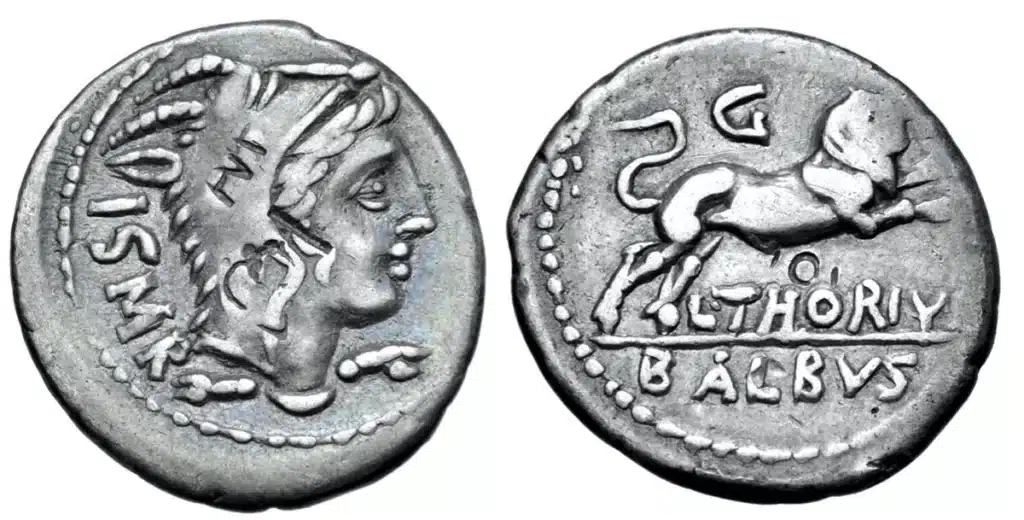
16 June 2021. Lot: 1305. Realized: £130. Approx. $183.
An early appearance of Juno Sospita is on the obverse of a silver denarius issued by the moneyer L. Thorius Balbus in 105 BCE[4]. On the obverse, she is depicted wearing a goatskin headdress with the horns still attached. The inscription I S M R stands for the Latin phrase Iuno Sospita Mater Regina (“Juno the Savior, Mother [and] Queen”).
Moneyers were mint officials, elected annually and responsible for producing the coins. They often used this opportunity to promote their political careers. Thorius came from the town of Lanuvium[5], 20 miles (32 km) southeast of Rome, where there was an important temple dedicated to the goddess.

13 May 2020. Lot: 629. Realized: $3,000.
Juno Sospita with her goatskin headdress appears on numerous coins from the “Imperatorial” period (59 to 27 BCE) when Rome was wracked by a series of civil wars. L Papius Celsus, a moneyer who is known only from his coinage, also came from Lanuvium, and the reverse of his silver denarius[6] issued in 45 BCE has a strange scene from the legendary founding of that city:
When a fire broke out spontaneously in the forest, a wolf, they say, brought some dry wood in his mouth and threw it upon the fire, and an eagle, flying thither, fanned the flame with the motion of his wings. But working in opposition to these, a fox, after wetting his tail in the river, endeavoured to beat out the flames; and now those that were kindling it would prevail, and now the fox that was trying to put it out. But at last the two former got the upper hand, and the other went away, unable to do anything further. 5 Aeneas, on observing this, said that the colony would become illustrious and an object of wonder and would gain the greatest renown[7].
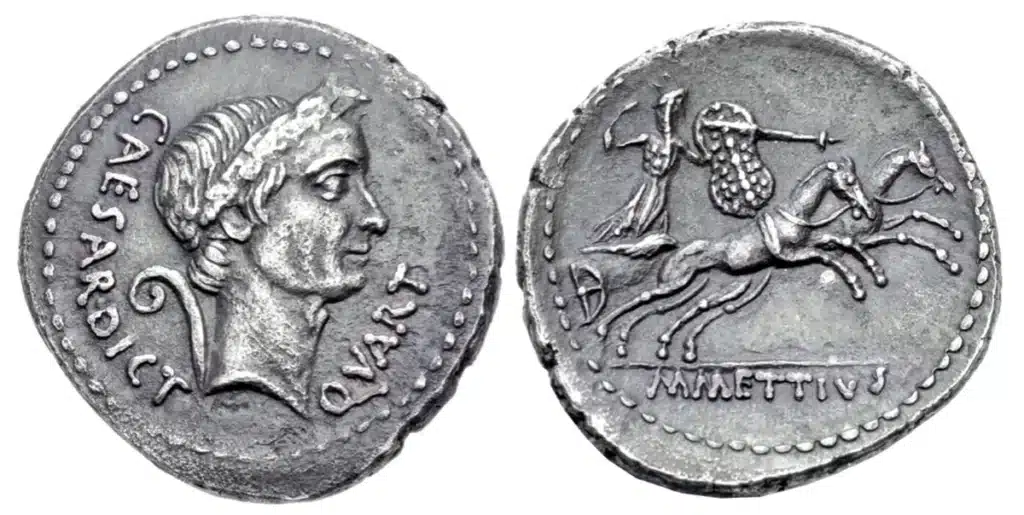
Coins bearing the portrait of Julius Caesar issued during his lifetime are in great demand from collectors, and often command fabulous prices at auction. Elite Romans of this era, much like modern Americans, were against the depiction of living persons on the money. They regarded this as a decadent “Eastern” custom. Early in 44 BCE, when Caesar was declared dictator for the fourth time, yet another Lanuvian, M. Mettius, placed the image of Juno Sospita on the reverse of Caesar’s portrait denarius[8]. The goddess, armed with a spear and a figure-of-eight shield, stands in a chariot drawn by two slim leaping horses.
Three months after this coin was struck, Caesar was assassinated.
Juno Moneta
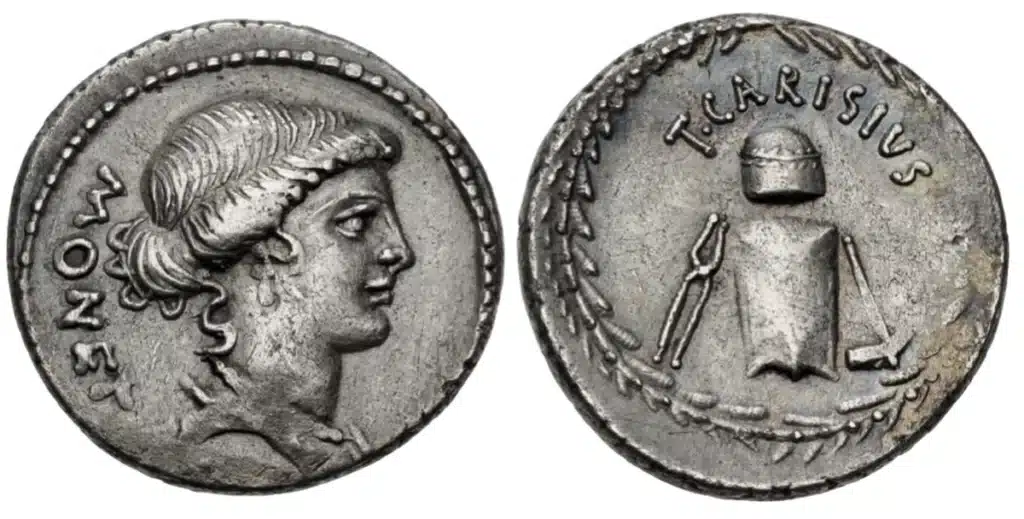
Lot: 749. Realized: $2,000.
Juno Moneta (“the Warner”) appears on a denarius of the moneyer T. Carisius issued in 46 BCE. Her hair is tied back with ribbons and her epithet MONETA is inscribed behind her head. Not much is known about Titus Carisius. He was a supporter of Julius Caesar who survived the civil wars and was “defeated the Astures in Hispania circa 25 BCE but in consequence of his cruelty and insolence, the Astures took up arms again in 22 BC[9].”
This coin is enormously popular with collectors because it is one of the few types that depicts the implements used to strike ancient coins[10]. One the reverse, we see a hammer, an anvil, a pair of tongs used to handle hot blanks, and a decorated rounded object that is usually described as a “Vulcan’s cap”, the leather hat worn by metal workers to keep flying sparks from setting their hair on fire. Some sources describe this object as a “garlanded punch die”, but this now seems to be a minority opinion.
Juno Lucina
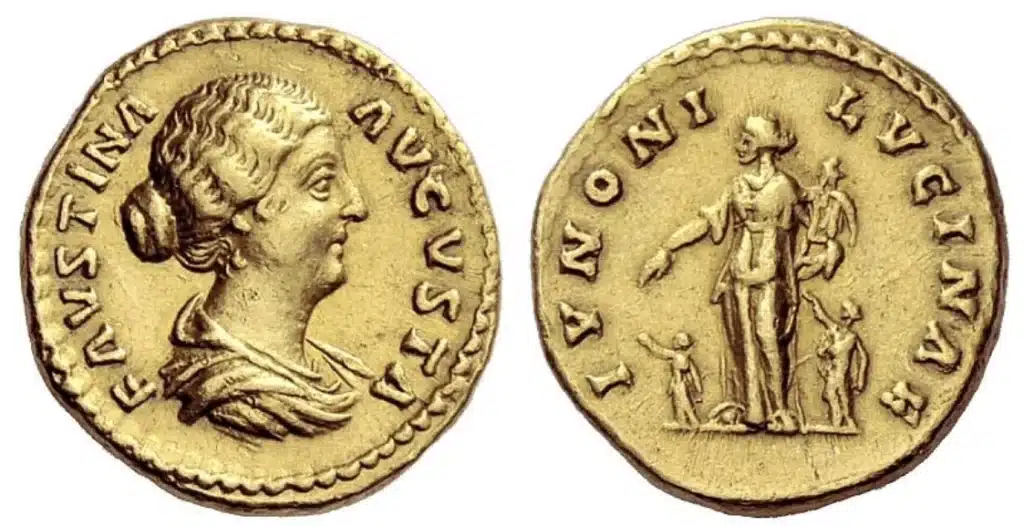 Auction 67 17 October 2012 Lot: 353 realized: 4,500 CHF Approx. $4,876 ” width=”696″ height=”358″ />
Auction 67 17 October 2012 Lot: 353 realized: 4,500 CHF Approx. $4,876 ” width=”696″ height=”358″ />Faustina “the Younger” (born about 130 CE) was the daughter of Emperor Antoninus Pius (ruled 138-161) and the wife of Emperor Marcus Aurelius (r. 161-180). She is known as Faustina Junior, or “the Younger” to distinguish her from her mother Faustina “the Elder”. In 30 years of marriage, she bore 14 children, of which six survived to adulthood: five daughters and one son, and the future emperor Commodus.
The reverse of a gold aureus in Faustina’s name, dated to c. 161-176 CE, bears a standing figure of Juno flanked by two small children and holding an infant in her arms. The inscription is IVNONI LUCINAE (“to Juno Lucina”), an appropriate invocation to the patron deity of childbirth. This coin, formerly in the famous collection of Archer Huntington, brought over $4,800 USD in a 2012 Swiss auction[11].
Juno on Coins of Bruttia Crispina
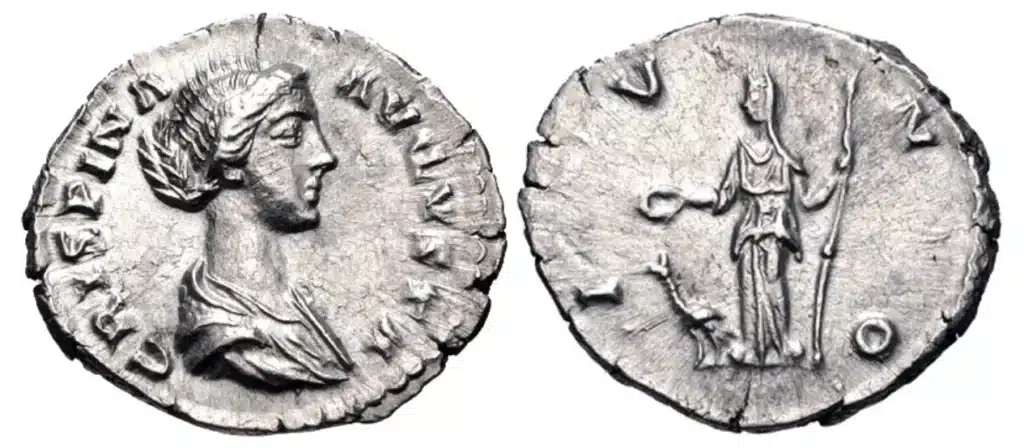 Electronic Auction 42525 July 2018 Lot: 466 realized: $100 ” width=”696″ height=”305″ />
Electronic Auction 42525 July 2018 Lot: 466 realized: $100 ” width=”696″ height=”305″ />Born to a wealthy Senatorial family, Bruttia Crispina (164-191 CE) married the 16-year-old future emperor Commodus in 178. Failing to produce an heir to the throne, she was falsely accused of adultery by her increasingly paranoid husband in 188. Banished to the island of Capri in the Gulf of Naples, she was executed a few years later. She was only about 26 years old. Her portrait appears on a long series of imperial coins, such as a silver denarius dated to c. 178-182[12]. A standing figure of Juno, accompanied by her familiar peacock, appears on the reverse holding a long staff and a patera, a shallow bowl used to pour out ritual offerings[13]. The simple inscription is IVNO.
Juno on Coins of Manlia Scantilla
 Auction 135: 21 November 2022 Lot: 317 realized: 240,000 CHF Approx. $252,260″ width=”696″ height=”349″ />
Auction 135: 21 November 2022 Lot: 317 realized: 240,000 CHF Approx. $252,260″ width=”696″ height=”349″ />: 21 November 2022. Lot: 317. Realized: 240,000 CHF. Approx. $252,260.
Manlia Scantilla was the wife of Emperor Didius Julianus, who ruled for just 66 days in the chaotic year 193 CE. Almost nothing is known about her life; the gold aureus issued in her name is one of the great rarities of Roman imperial coinage. An example described as “among the finest specimens known,” brought over $250,000 in a 2022 Swiss auction[14]. The reverse bears a draped and veiled standing figure of Juno, with her staff, patera, and peacock, surrounded by the inscription IVNO • REGINA (“Juno Queen”).
Juno Conservatrix
6 November 2022
Lot: 808
realized: €120 Approx. $1195 May 2010 Lot: 1320 realized: $23,000. Numismatik Naumann (formerly Gitbud & Naumann) > Auction 122 6 November 2022 Lot: 808 realized: €120 Approx. $119″ width=”696″ height=”363″ />
Julia Avita Mamaea (182 – 235) was born to an elite family in Emesa (today Homs), Syria. Her mother, Julia Maesa, was the elder sister of Empress Julia Domna, wife of Emperor Septimius Severus (r. 193-211). These ruthless and intelligent Syrian women, all rather confusingly named Julia, dominated the politics of the Empire for a troubled generation.
Julia Mamaea’s son, Severus Alexander (r. 222-235), became child emperor at the age of about 14 when his depraved cousin, the emperor Elagabalus, and his mother, Julia Soaemias, were murdered in a palace coup on March 11 or 12 in the year 222 CE.
Julia Mamaea was the effective ruler of the Empire during her son’s reign, and an extensive coinage was issued in her name bearing her portrait. The reverse of a silver denarius[15] bears the standard standing image of Juno, with star, patera, and peacock, surrounded by the unusual inscription IVNO CONSERVATRIX (“Juno the Preserver”).
Juno Martialis
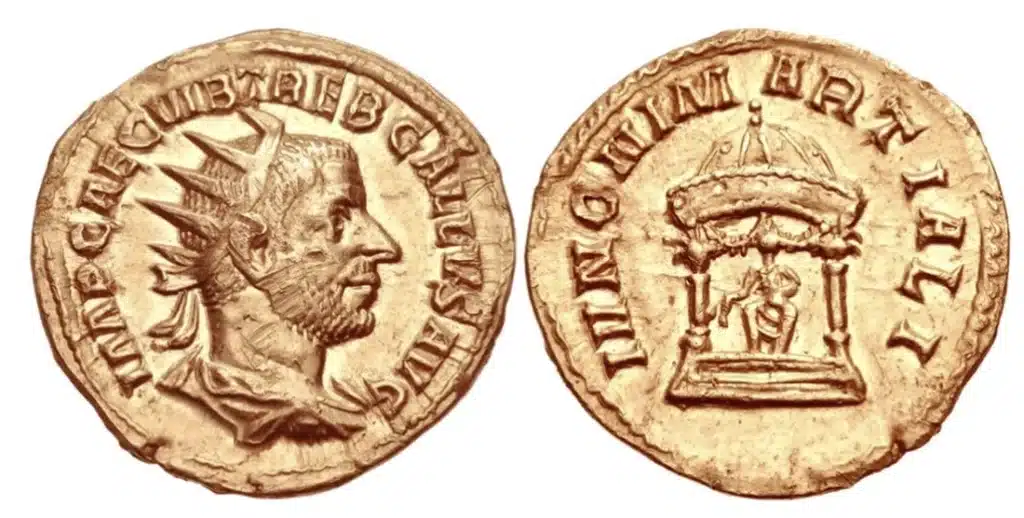 Mail Bid Sale 845 May 2010 Lot: 1320 realized: $23,000 ” width=”696″ height=”352″ />
Mail Bid Sale 845 May 2010 Lot: 1320 realized: $23,000 ” width=”696″ height=”352″ />Born about 206 CE to a respected elite family, Trebonianus Gallus had a successful military career, becoming governor of the strategic province of Moesia Superior (now mostly modern Serbia) under Emperor Trajan Decius. After Decius was killed in battle against the Germanic Goths, Trebonianus was confirmed as emperor by the Roman Senate, with his son Volusian as co-emperor. Trebonianus adopted Juno Martialis (Juno in her aspect as mother of the war god Mars) as his patron deity.
On coins[16] of Trebonianus and Volusian, the goddess is depicted enthroned under an elaborate columned canopy, with the inscription IVNONI MARTIALI (“to Juno Martialis”). When the legions under Aemilian revolted in 253 CE, Trebonianus and his son were murdered, a common fate for emperors during the Crisis of the Third Century.
Juno Victrix
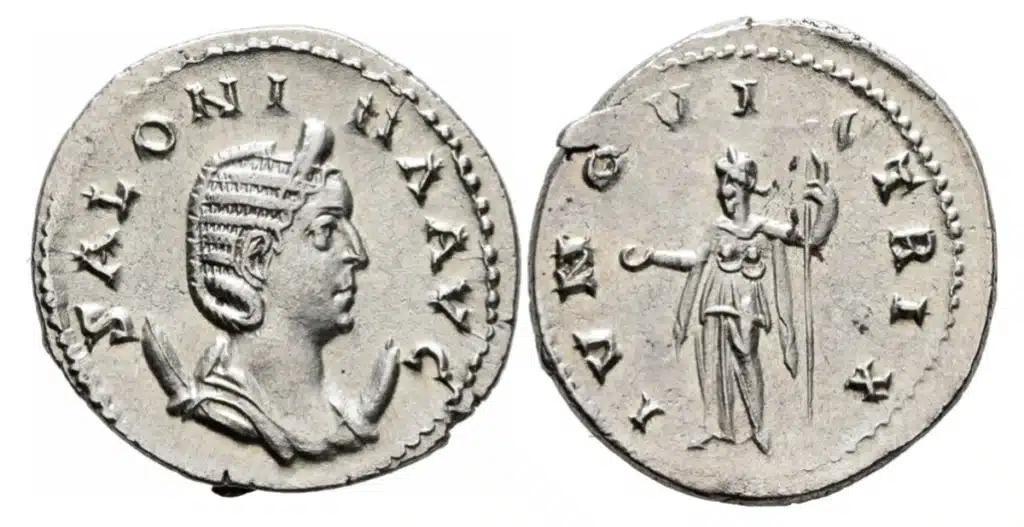 Web Auction 24. 3 December 2022. Lot: 3100.Realized: 220 CHF Approx. $234″ width=”696″ height=”358″ />
Web Auction 24. 3 December 2022. Lot: 3100.Realized: 220 CHF Approx. $234″ width=”696″ height=”358″ />Lot: 3100
realized: 220 CHF. Approx. $234
Cornelia Salonina was the wife of Emperor Gallienus (r. 253-268), who became co-emperor with his father Valerian in 253. After his father was captured in battle against the Persians in 260, Gallienus ruled alone until he was assassinated in 268. Salonina’s fate after her husband’s death is unknown, but she bore him three sons.
Coins issued in her name bear a variety of symbols and goddesses, including Vesta, Venus, Ceres, and Juno. One type of silver antoninianus[17] depicting Juno has the unusual inscription IVNO VICTRIX (“Juno the Conqueror”), which appears on no other Roman coins. “Conqueror” is a peculiar epithet for a goddess, but understandable, perhaps, in this strife-torn era.
Zenobia
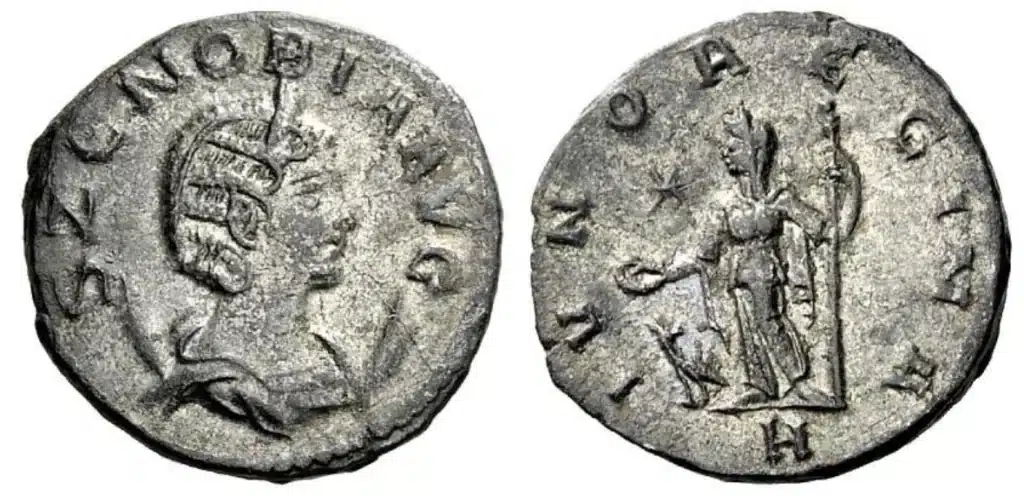 Auction 6417 May 2012 Lot: 1266 realized: 18,000 CHF Approx. $19,044″ width=”696″ height=”337″ />
Auction 6417 May 2012 Lot: 1266 realized: 18,000 CHF Approx. $19,044″ width=”696″ height=”337″ />One of the most remarkable women of the third century CE, Zenobia[18] (born about 240) was queen of the wealthy Syrian oasis city of Palmyra[19]. As a client of the Roman Empire, her husband, King Odaenathus, fought successfully against the Persians until he was assassinated in late 267. As regent for her son Vaballathus, Zenobia led a series of campaigns that brought much of the Roman Empire in the East, including Egypt, under her control. Fluent in Greek, Latin, Coptic, and her native Aramaic, she was a cultured and tolerant ruler of a vast multi-ethnic state.
Rare coinage in her name[20], issued from Antioch or possibly Emesa, followed standard Roman conventions, with Latin inscriptions and a reverse depicting IVNO REGINA (“Queen Juno”). Defeated by Emperor Aurelian in 272, Zenobia was paraded triumphantly in Rome (according to legend, in golden chains) and lived out the rest of her life in comfortable retirement.
* * *
Notes
[1] There is no letter “J” in Classical Latin. The letter only came into use in modern languages after the development of printing in the 16th century CE.
[2] https://en.wikipedia.org/wiki/Interpretatio_graeca
[3] https://en.wikipedia.org/wiki/Temple_of_Juno_Moneta
[4] Roma Numismatics e-Sale 64,June 16, 2021, Lot 1305. Realized £130 (about $183 USD; estimate £100).
[5] https://en.wikipedia.org/wiki/Lanuvium
[6] CNG Auction 114, May 13, 2020, Lot 629. Realized $3,000 USD (estimate $500).
[7] Dionysius of Halicarnassus (1937) i, 59.
[8] CNG Triton XV, January 3, 2012, Lot 1481. Realized $55,000 USD (estimate $20,000).
[9] http://numis.org/coins-of-the-month/may-2022-spotlight/
[10] CNG Auction 124, October 6, 2022, Lot 749. Realized $2,000 USD (estimate $1,000).
[11] NAC Auction 67, October 17, 2012, Lot 353. Realized CHF 4,500 (about $4,876 USD; estimate CHF 3,750).
[12] CNG E-auction 425, July 25, 2018, Lot 466. Realized $100 USD (estimate $150).
[13] https://en.wikipedia.org/wiki/Patera
[14] NAC Auction 125, November 21, 2022, Lot 317. Realized CHF 240,000 (about $252,260 USD; estimate CHF 125,000).
[15] Numismatik Naumann Auction 122, November 6, 2022, Lot 808. Realized €120 (about $119 USD; estimate €40).
[16] CNG Sale 84, May 5, 2010, Lot 1320. Realized $23,000 USD (estimate $20,000).
[17] Leu Web Auction 24, December 3, 2022, Lot 3100. Realized CHF 220 (about $234 USD; estimate CHF 25).
[18] https://en.wikipedia.org/wiki/Zenobia
[19] The UNESCO World Heritage site of Palmyra was extensively destroyed by the so-called “Islamic State” in 2015 in one of the 21st century’s worst acts of cultural vandalism.
[20] NAC Auction 64, May 17, 2012, Lot 1266. Realized CHF 18,000 (about $19,044 USD; estimate CHF 15, 000).
References
Adkins, Lesley and Roy Adkins. Dictionary of Roman Religion. New York (1996)
Berk, Harlan. 100 Greatest Ancient Coins. Whitman: Pelham, AL (2019)
Dionysius of Halicarnassus. Roman Antiquities (Earnest Cary, Translator). Cambridge, MA (1937)
Kent, J.P.C. Roman Coins. New York (1978)
Sear, David. Roman Coins and Their Values, Vol. 1. London (2000)
Stevenson, Seth. Dictionary of Roman Coins. London (1964 reprint of 1889 edition)
Vagi, David. Coinage and History of the Roman Empire. Sidney, OH (1999)
* * *
The post Juno on Ancient Coins – Roman Queen of the Gods appeared first on CoinWeek: Rare Coin, Currency, and Bullion News for Collectors.